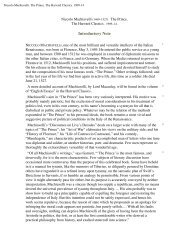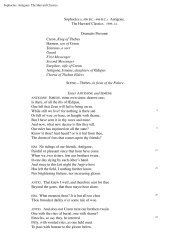Notre Dame de Paris - Bartleby.com
Notre Dame de Paris - Bartleby.com
Notre Dame de Paris - Bartleby.com
Create successful ePaper yourself
Turn your PDF publications into a flip-book with our unique Google optimized e-Paper software.
was the bol<strong>de</strong>st, airiest, most elaborate and serrated spire that ever showed the sky through its fretted<br />
cone.<br />
Just in front of <strong>Notre</strong> <strong>Dame</strong> three streets opened into the Cathedral close—a fine square of old houses.<br />
On the south si<strong>de</strong> of this glowered the furrowed, beetling front of the Hôtel-Dieu, with its roof as if<br />
covered with boils and warts. Then, on every si<strong>de</strong>, right, left, east, and west, all within the narrow circuit<br />
of the City, rose the steeples of its twenty-one churches, of all dates, shapes, and sizes, from the low,<br />
worm-eaten Roman belfry of Saint-Denis du Pas (carcer Glaucini) to the slen<strong>de</strong>r, tapering spires of<br />
Saint-Pierre aux Bœufs and Saint-Landry. Behind <strong>Notre</strong> <strong>Dame</strong> northward, stretched the cloister with its<br />
Gothic galleries; southward, the semi-Roman palace of the Bishop, and eastward, an uncultivated piece<br />
of ground, the terrain, at the point of the island. Furthermore, in this sea of houses, the eye could<br />
distinguish, by the high, perforated mitres of stone which at that period capped even its topmost attic<br />
windows, the palace presented by the town, in the reign of Charles VI, to Juvénal <strong>de</strong>s Ursins; a little<br />
farther on, the black-barred roofs of the market-shed in the Marché Palus; farther off still, the new<br />
chancel of Saint-Germain le Vieux, lengthened in 1458 by taking in a piece of the Rue aux Febves with<br />
here and there a glimpse of causeway, crow<strong>de</strong>d with people, some pillory at a corner of the street, some<br />
fine piece of the pavement of Philip Augustus—magnificent flagging, furrowed in the middle for the<br />
benefit of the horses, and so badly replaced in the middle of the sixteenth century by the wretched<br />
cobblestones called “pavé <strong>de</strong> la Ligue”; some solitary court-yard with one of those diaphanous<br />
wrought-iron stair-case turrets they were so fond of in the fifteenth century, one of which is still to be<br />
seen in the Rue <strong>de</strong>s Bourdonnais. Lastly, to the right of the Sainte-Chapelle, westward, the Palais <strong>de</strong><br />
Justice displayed its group of towers by the water’s edge. The trees of the royal gar<strong>de</strong>ns, which occupied<br />
the western point of the island, hid the ferry-man’s islet from view. As for the water, it was hardly visible<br />
on either si<strong>de</strong> of the City from the towers of <strong>Notre</strong> <strong>Dame</strong>: the Seine disappeared un<strong>de</strong>r the bridges, and<br />
the bridges un<strong>de</strong>r the houses.<br />
And when one looked beyond these bridges, on which the house-roofs glimmered green—moss-grown<br />
before their time from the mists of the river—and turned one’s gaze to the left towards the University,<br />
the first building which caught the eye was a low, extensive cluster of towers, the Petit-Châtelet, whose<br />
yawning gateway swallowed up the end of the Petit-Pont. Then, if you ran your eye along the river bank<br />
from east to west, from the Tournelle to the Tour <strong>de</strong> Nesle, it was one long line of houses with sculptured<br />
beams, coloured windows, overhanging storeys jutting out over the roadway—an interminable zigzag of<br />
gabled houses broken frequently by the opening of some street, now and then by the frontage or corner of<br />
some grand mansion with its gar<strong>de</strong>ns and its court-yards, its wings and outbuildings; standing proudly<br />
there in the midst of this crowding, hustling throng of houses, like a grand seigneur among a mob of<br />
rustics. There were five or six of these palaces along the quay, from the Logis <strong>de</strong> Lorraine, which shared<br />
with the Bernardines the great neighbouring enclosure of the Tournelle, to the Tour <strong>de</strong> Nesle, the chief<br />
tower of which formed the boundary of <strong>Paris</strong>, and whose pointed gables were accustomed, for three<br />
months of the year, to cut with their black triangles the scarlet disk of the setting sun.<br />
Altogether, this si<strong>de</strong> of the Seine was the least mercantile of the two: there was more noise and<br />
crowding of scholars than artisans, and there was no quay, properly speaking, except between the Pont<br />
Saint-Michel and the Tour <strong>de</strong> Nesle. The rest of the river bank was either a bare strand, like that beyond<br />
the Bernardine Monastery, or a row of houses with their feet in the water, as between the two bridges.<br />
This was the domain of the washerwomen; here they called to one another, chattered, laughed, and sang,<br />
from morning till night along the river si<strong>de</strong>, while they beat the linen vigorously—as they do to this day,<br />
contributing not a little to the gaiety of <strong>Paris</strong>.










